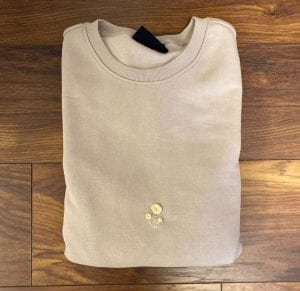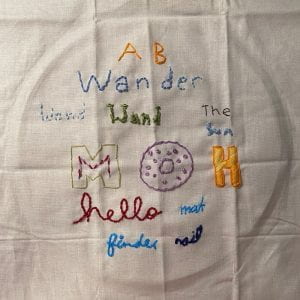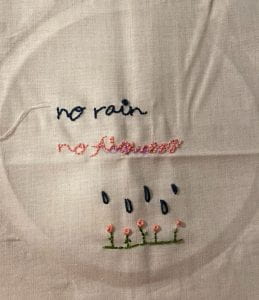“Although the threads of my life have often seemed knotted, I know, by faith, that on the other side of the embroidery there is a crown.”
– Corrie ten Boom
Welcome back!
This post will be about my two new projects, some updates with my mentor, and challenges I’ve had.
Progress Report
Since my last post, I have finished my fabrics project, but due to events over spring break, I had to push the project’s due date by a week. For my first sub-project for this one, I had told you I was trying tulle embroidery. For the idea, Michelle said I would go ahead with my koi pond. Since the project was on a new medium, it was hard to adjust to at first, and since it’s a “loose” fabric, I had to use thicker threads. I used many, many French knots, backstitches, and lazy daisies, so it wasn’t too difficult. Overall, though, this project turned out much better than I had thought, and I thoroughly enjoyed the process of it.

As for my second sub-project, I had embroidered a plain sweater I have, stitching on some of my favorites flower patterns. For my first try, I tried to stitch on a flower on the top right corner of my sweater, it consisted of many French knots and a couple of lazy daisies, but the design ended up in a strange spot, so I had to remove the stitches. This was really frustrating as the many knots required more thread, and I had used quite a bit of it. For my second try, I did three woven wheels of different sizes in the center of my sweater, the design was a little too low for my liking, but I was satisfied with the minimalistic look it had.

For my last project before my final piece, Michelle and I have decided for me to learn some scenery patterns including, trees and maybe animals.
Mentor
- What has been your most difficult mentoring challenge so far? Why?
Especially for the past few weeks, Michelle and I’s call schedule has been rocky due to timing and other commitments. Michelle has been quite busy over the break with her kids and trips, so we had to reschedule quite a bit. Michelle was away from home for a few days for a trip too, so we couldn’t communicate as effectively during that time. I did update Michelle when I could through messages, giving her progress reports and ideas I was thinking about.
- What is working well? Why?
Even though we have had trouble communicating effectively lately, Michelle has been helping me with questions I have, and she has given me feedback for projects I’ve done. On our most recent call, we were deciding on what I should do for my fifth project, and Michelle recommended I try scenery, and I could incorporate that into a Mother’s Day project as that is coming up. I also told her about what I planned to stitch onto my sweater for the second part of my last project. Overall, when choosing new projects for me, Michelle helps me think of fun and challenging ways to use my skills.
- What could be working better? How can you make sure this happens?
As I mentioned before, Michele and I have had trouble communicating recently. To fix this, I plan to get our biweekly calls back on track, and since Michelle will likely be in the area for a while, we won’t have too many problems. I can continue to update her in the time between our calls, and we can message each other in case of trips for cancellations.
Frustrations
I had planned to work on my fabric project over the break quite a bit, but due to other events I had fallen behind quite a bit. To catch up, I ended up pushing my dates by a week. I did finish my project within the new time though, and I am back on track now.
As for the project itself, it was definitely tough at first for both pieces; for the pond I found it hard to make my stitches as accurate, and I needed to use all six threads to cover a space. For the sweater, the placement of the design was difficult, as well as putting the hoop on, since the sweater’s fabric was a lot thicker, my hoop refused to close as first.
Updated Timeline
| Plan: An outline of methods, activities, strategies, people, and resources you can use to meet your challenge | Timetable: The specific dates or times when you will accomplish the steps in your plan |
| Find a vision or goal. | Before December 17th (done) |
| Find and contact a mentor. | Before December 20th (done) |
| Make sure mentor has completed necessary forms. | January 12th (done) |
| Do some research on embroidery. | December 31st – January 10th (done) |
| Start finding stitches I want to learn. | January 3rd – January 10th (done) |
| Find four types of patterns that I want to work on and two types of fabrics. | Before January 31st (done) |
| Buy (most) needed supplies. | Before January 31st (done) |
| Start learning and practicing stitches. | January 16th – January 31st (done) |
| Start practicing a certain genre and complete a design for first mini project. | Before January 31st (done) |
| Finish first mini project. | February 6th (done) |
| Learn to care for finished product. | February 6th (done) |
| Start working on second genre. | February 7th (done) |
| Finish and care for second project. | February 28th done) |
| Finish and care for third project. | March 28th (done) |
| Finish and care for fourth project. | April 18th (in progress) |
| Finish final project. | May 22nd |
| Complete a journal of what I have learnt and this journey. | May 28th (in progress) |



